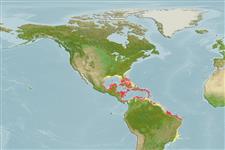Common names from other countries
>
Perciformes/Serranoidei (Groupers) >
Liopropomatidae (Painted basslets) > Liopropomatinae
Etymology: Liopropoma: Greek, leio = smooth + Greek, pro = in front of + Greek, poma, -atos = cover, operculum (Ref. 45335).
More on author: Poey.
Environment: milieu / climate zone / depth range / distribution range
Ekologi
laut berasosiasi dengan karang; kisaran kedalaman 3 - 45 m (Ref. 9710). Tropical
Western Atlantic: southern Florida, USA and Bahamas to northern South America.
Size / Weight / umur
Maturity: Lm ? range ? - ? cm
Max length : 10.0 cm TL jantan/; (Ref. 26938)
Duri punggung (Keseluruhan (total)): 6 - 7; duri punggung lunak (Keseluruhan (total)): 12. Body yellow-orange with 5 wide black lines along side bordered by red above and below. Large black spot on second dorsal fin; similar spot on anal fin; caudal fin has 2 black spots connected by black bar.
A solitary species (Ref. 26340) inhabiting deep recesses of coral reefs. Common, but secretive and rarely seen (Ref. 9710). The maximum size for this species is about 8 cm standard length or 100 mm TL (value from Ref. 26938) (P.Heemstra, pers.comm. 12/09).
Life cycle and mating behavior
Kematangan | Reproduksi, perkembang biakan | Pemijahan | telur-telur | Fecundity | Larva
Robins, C.R. and G.C. Ray, 1986. A field guide to Atlantic coast fishes of North America. Houghton Mifflin Company, Boston, U.S.A. 354 p. (Ref. 7251)
Status IUCN Red List (Ref. 130435)
CITES (Ref. 128078)
Not Evaluated
ancaman kepada manusia
Harmless
penggunaan manusia
Akuarium: Komersial
informasi lanjut
AcuanBudidaya airprofil budidaya airStrainGenetikaElectrophoresesDiturunkanPenyakit-penyakitPengolahanMass conversion
Alat, peralatan
laporan khas
muat turun XML
Sumber internet
Estimates based on models
Preferred temperature (Ref.
115969): 25.4 - 28, mean 27.2 (based on 200 cells).
Phylogenetic diversity index (Ref.
82804): PD
50 = 0.5000 [Uniqueness, from 0.5 = low to 2.0 = high].
Bayesian length-weight: a=0.01122 (0.00514 - 0.02450), b=3.04 (2.87 - 3.21), in cm Total Length, based on all LWR estimates for this body shape (Ref.
93245).
Trophic level (Ref.
69278): 3.7 ±0.6 se; based on size and trophs of closest relatives
Fishing Vulnerability (Ref.
59153): Low vulnerability (10 of 100).
